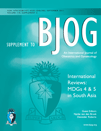
This supplement demonstrates the strengths of an effective global collaboration of clinicians, researchers, Ministries of Health, and WHO offices. Further efforts will be needed to continue the analytical work of this data set, including the combination of the 2004–2008 Global Survey and the 2010–2011 WHOMCS data sets: together, these databases have recorded data for more than 600 000 women and their newborns. Nevertheless, beyond the scientific articles, greater efforts will be required to put these findings and other valuable information into action, in order to improve the health of families, women, and children around the world. While acknowledging the obstacles, we are confident that with focus, persistence, and collaboration, science and health policy can work together to bring better lives to the most vulnerable populations.
The selection above was taken from “The World Health Organization Multi-country Survey on Maternal and Newborn Health project at a glance: the power of collaboration” editorial by J. Souza. Please click here to read the full editorial and to see a comprehensive list of references.